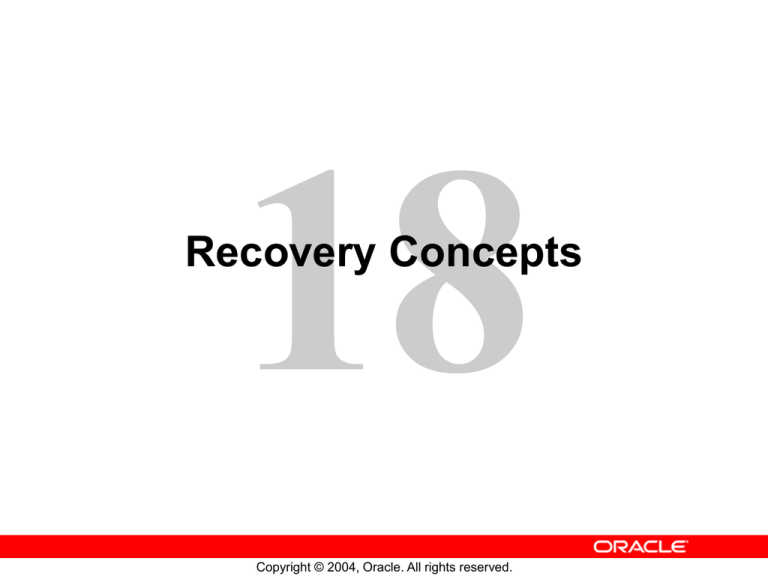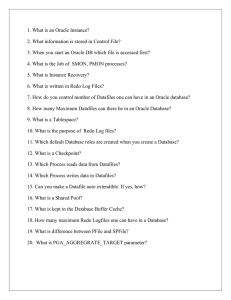
Recovery Concepts
Copyright © 2004, Oracle. All rights reserved.
Objectives
After completing this you should be able to do the
following:
• List the types of failure that may occur in an
Oracle Database.
• Describe ways to tune instance recovery.
• Identify the importance of checkpoints, redo log
files, and archived log files.
• Configure ARCHIVELOG mode.
18-2
Copyright © 2004, Oracle. All rights reserved.
Backup and Recovery Issues
The administrator’s duty is to:
• Protect the database from failure wherever
possible.
• Increase the Mean-Time-Between-Failures (MTBF).
• Decrease the Mean-Time-To-Recover (MTTR).
• Minimize the loss of data.
18-3
Copyright © 2004, Oracle. All rights reserved.
Categories of Failures
Failures can generally be divided into the following
categories:
• Statement failure
• User process failure
• Network failure
• User error
• Instance failure
• Media failure
18-4
Copyright © 2004, Oracle. All rights reserved.
Statement Failures
Typical Problems
Possible Solutions
Attempts to enter invalid
data into a table
Work with users to validate
and correct data.
Attempts to perform
operations with
insufficient privileges
Provide appropriate object or
system privileges.
Attempts to allocate space Enable resumable space
that fail
allocation.
Increase user quota.
Add space to tablespace.
Logic errors in
applications
18-5
Work with developers to
correct program errors.
Copyright © 2004, Oracle. All rights reserved.
User Process Failure
Typical Problems
Possible Solutions
User performed an
abnormal disconnect.
DBA action is not usually
needed to resolve user
process failures. Instance
background processes roll
back uncommitted changes
and release locks.
User’s session was
abnormally terminated.
User experienced a
program error which
terminated the session.
18-6
Watch for trends.
Copyright © 2004, Oracle. All rights reserved.
Network Failure
18-7
Typical Problems
Possible Solutions
Listener fails
Configure a backup listener
and connect-time failover.
Network Interface Card
(NIC) fails
Configure multiple network
cards.
Network connection fails
Configure a backup network
connection.
Copyright © 2004, Oracle. All rights reserved.
User Errors
Typical Causes
Possible Solutions
User inadvertently
Roll back or use flashback
deletes or modifies data. query to recover.
User drops a table.
18-8
Recover table from recycle bin.
Copyright © 2004, Oracle. All rights reserved.
Instance Failure
Typical Causes
Possible Solutions
Power outage
Restart the instance using the
“startup” command. Recovery
from instance failure is
automatic including rolling
forward changes in the redo
logs and then rolling back any
uncommitted transactions.
Hardware failure
Failure of one of the
background processes
Emergency shutdown
procedures
18-9
Investigate causes of failure
using the alert log, trace files,
and Enterprise Manager.
Copyright © 2004, Oracle. All rights reserved.
Instance Recovery
Instance or crash recovery:
• Is caused by attempts to open a database whose
files were not synchronized on shutdown
• Is automatic
• Uses information stored in redo log groups to
synchronize files
• Involves two distinct operations
– Rolling forward: Data files are restored to their state
before the instance failed.
– Rolling back: Changes made but not committed are
returned to their original state.
18-10
Copyright © 2004, Oracle. All rights reserved.
Phases of Instance Recovery
Instance
1. Data files out-of-sync
2. Roll forward (redo)
3. Committed and noncommitted data in files
4. Roll back (undo)
5. Committed data in files
SGA
146.5
Background
Processes
Data File
SCN: 140
Control File
SCN: 143
Redo Log
Group
SCN 74-101
Undo
Data File
SCN: 129
Control File
SCN: 143
Redo Log
Group
SCN 102-143
Data File
SCN: 99
18-11
Database
Copyright © 2004, Oracle. All rights reserved.
Tuning Instance Recovery
•
•
During instance recovery the transactions
between the checkpoint position and end of redo
log must be applied to the data files.
Tune instance recovery by controlling the
difference between the checkpoint position and
end of redo log.
Checkpoint position
End of redo log
Instance recovery
Transactions
18-12
Copyright © 2004, Oracle. All rights reserved.
Using the MTTR Advisor
•
•
•
18-13
Specify the desired time in seconds or minutes.
Default value is 0 (disabled).
Maximum value is 3600 seconds (one hour).
Copyright © 2004, Oracle. All rights reserved.
Media Failure
Typical Causes
Possible Solutions
Failure of disk drive
1. Restore the affected file
from backup.
Failure of disk controller 2. If necessary, inform the
database of a new file
location.
Deletion or corruption of 3. If necessary, recover the file
by applying redo
database file
information.
18-14
Copyright © 2004, Oracle. All rights reserved.
Configuring for Recoverability
To configure your database for maximum
recoverability:
• Schedule regular backups
• Multiplex control files
• Multiplex redo log groups
• Retain archived copies of redo logs
18-15
Copyright © 2004, Oracle. All rights reserved.
Control Files
Protect against database failure by multiplexing
control files.
• At least two copies (Oracle suggests three)
• Each copy on a separate disk
• At least one copy on a separate disk controller
Control Files
18-16
Copyright © 2004, Oracle. All rights reserved.
Redo Log Files
Multiplexing redo log groups to protect against media
failure and loss of data.
• At least two members (files) per group
• Each member on a separate disk drive
• Each member on a separate disk controller
• Redo logs heavily influence performance
18-17
Disk 1
Member 1
Member 2
Member 1
Disk 2
Member 2
Member 1
Member 2
Group 1
Group 2
Group 3
Copyright © 2004, Oracle. All rights reserved.
Multiplexing the Redo Log
18-18
Copyright © 2004, Oracle. All rights reserved.
Archived Log Files
To preserve redo information, create archived copies
of redo log files.
• Specify archived log file naming convention.
• Specify one or more locations to archive logs to.
• Switch the database to ARCHIVELOG mode.
Online Redo Log Files
18-19
Archived log files
Copyright © 2004, Oracle. All rights reserved.
Archive Log File Naming and Destinations
Specify archived log file name and destinations.
18-20
Copyright © 2004, Oracle. All rights reserved.
ARCHIVELOG Mode
Place the database in ARCHIVELOG mode.
• Click the ARCHIVELOG Mode checkbox
•
18-21
Click Apply. The database can only be set to
ARCHIVELOG mode from the MOUNT state. Click Yes
when asked if you want to restart the database.
Copyright © 2004, Oracle. All rights reserved.
Summary
In this lesson you should have learned how to:
• Describe the basics of database backup, restore
and recovery
• List the types of failure that may occur in an
Oracle Database
• Identify the importance of checkpoints, redo log
files, and archived log files
• Configure ARCHIVELOG mode
•
18-22
Describe ways to tune instance recovery
Copyright © 2004, Oracle. All rights reserved.



